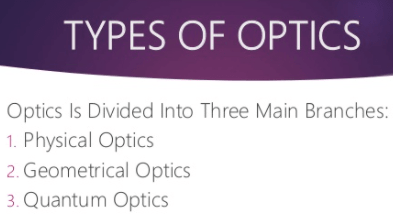Optics

Optics is part of the physics responsible for the study of light and the phenomena associated with it. As light presents a dual behavior, which can be considered as a wave or particle, Basically there are two types of optics:
- Physical optics – when considering the wave nature of light.
- Geometric optics – when light is considered a particle and its studies are based on the concept of light rays, providing a geometric model for light.
Important Definitions of Geometric Optics
As the focus of this text is only on Geometric Optics before we know its principles, let’s see some important definitions:
The light rays are straight line segments that represent the direction and direction of propagation of the light. They can be issued by two types of sources:
- Primary sources: that emit their own light, such as the sun, the flame of a candle or a lamp.
- Secondary sources: that reflect the light they receive from a primary source, such as the moon that reflects the light they receive from the sun, or a book, which can only be seen if it reflects the light it receives from a lamp.
Light sources can also be classified according to their size:
- Extensive sources: when they have considerable dimensions compared to the dimensions of the object to be illuminated. For example a lamp-lit near a book.
- Point sources: if the dimensions of the light source are considered negligible in relation to the object to be illuminated.
A set of light rays forms a beam of light. The light emitted by a point source propagates in all directions, so it is called a divergent beam of light rays. When the rays are parallel, as in the case of light emitted by a flashlight, we say that the beam of light is convergent.
Principles of Geometric Optics
There are three principles adopted by Geometric Optics to explain light phenomena.
The first is called the Rectilinear Propagation Principle of Light and states that:
“ Inhomogeneous and transparent environments, the light spreads in a straight line.”
This principle explains several phenomena, such as the geometric similarity between the shadow and the object that produces it, in addition to the formation of penumbra and eclipses.
The second principle of Geometric Optics is the independence of light rays, which has the following statement:
” When two or more beams of the light cross, one does not alter the propagation of the other.”
Finally, the third principle, which is the reversibility of light rays:
“ The path followed by light does not depend on its direction of propagation.”
Geometrical Optics is responsible for the study of various physical concepts, including the formation of shadow, gloom, and eclipse; the reflection and refraction of light, and the image formation in mirrors, lenses, and optical instruments.
Related Topics:
-
- Properties of Light
- Reflection of light examples
- Refraction of light examples
- Polarization of light
- Diffraction of light examples
- Types of Interference of light
- Types of Lenses
- Types of Spherical Mirrors
- Types of Optical fiber
- Difference between Mirror and Lense
- Difference between convex and Concave mirrors
- Convex Lens Vs Concave Lens
- Microscope Vs Telescope
- Types of telescopes
- Types of microscope
- Telescopes for kids
- Laser Action
- Laser
- Gas Lasers
- Doped Insulator Lasers
- Semiconductor Lasers
- Dye Lasers
- Dielectric Solids Lasers
For More Physics Topics Visit Our: Home Page